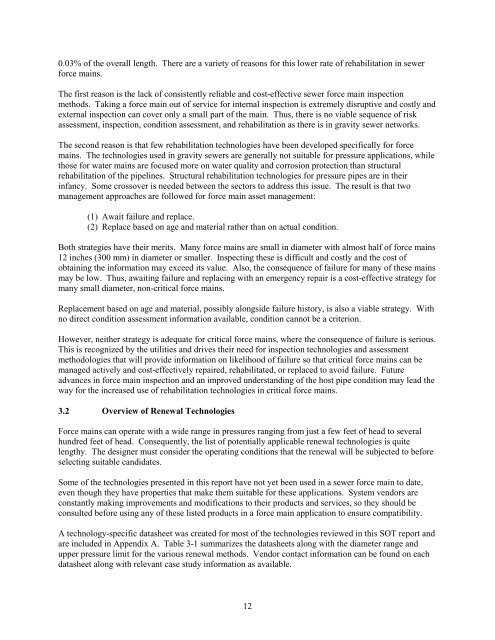State of Technology Report for Force Main Rehabilitation, Final ...
State of Technology Report for Force Main Rehabilitation, Final ...
State of Technology Report for Force Main Rehabilitation, Final ...
Create successful ePaper yourself
Turn your PDF publications into a flip-book with our unique Google optimized e-Paper software.
0.03% <strong>of</strong> the overall length. There are a variety <strong>of</strong> reasons <strong>for</strong> this lower rate <strong>of</strong> rehabilitation in sewer<br />
<strong>for</strong>ce mains.<br />
The first reason is the lack <strong>of</strong> consistently reliable and cost-effective sewer <strong>for</strong>ce main inspection<br />
methods. Taking a <strong>for</strong>ce main out <strong>of</strong> service <strong>for</strong> internal inspection is extremely disruptive and costly and<br />
external inspection can cover only a small part <strong>of</strong> the main. Thus, there is no viable sequence <strong>of</strong> risk<br />
assessment, inspection, condition assessment, and rehabilitation as there is in gravity sewer networks.<br />
The second reason is that few rehabilitation technologies have been developed specifically <strong>for</strong> <strong>for</strong>ce<br />
mains. The technologies used in gravity sewers are generally not suitable <strong>for</strong> pressure applications, while<br />
those <strong>for</strong> water mains are focused more on water quality and corrosion protection than structural<br />
rehabilitation <strong>of</strong> the pipelines. Structural rehabilitation technologies <strong>for</strong> pressure pipes are in their<br />
infancy. Some crossover is needed between the sectors to address this issue. The result is that two<br />
management approaches are followed <strong>for</strong> <strong>for</strong>ce main asset management:<br />
3.2<br />
(1) Await failure and replace.<br />
(2) Replace based on age and material rather than on actual condition.<br />
Both strategies have their merits. Many <strong>for</strong>ce mains are small in diameter with almost half <strong>of</strong> <strong>for</strong>ce mains<br />
12 inches (300 mm) in diameter or smaller. Inspecting these is difficult and costly and the cost <strong>of</strong><br />
obtaining the in<strong>for</strong>mation may exceed its value. Also, the consequence <strong>of</strong> failure <strong>for</strong> many <strong>of</strong> these mains<br />
may be low. Thus, awaiting failure and replacing with an emergency repair is a cost-effective strategy <strong>for</strong><br />
many small diameter, non-critical <strong>for</strong>ce mains.<br />
Replacement based on age and material, possibly alongside failure history, is also a viable strategy. With<br />
no direct condition assessment in<strong>for</strong>mation available, condition cannot be a criterion.<br />
However, neither strategy is adequate <strong>for</strong> critical <strong>for</strong>ce mains, where the consequence <strong>of</strong> failure is serious.<br />
This is recognized by the utilities and drives their need <strong>for</strong> inspection technologies and assessment<br />
methodologies that will provide in<strong>for</strong>mation on likelihood <strong>of</strong> failure so that critical <strong>for</strong>ce mains can be<br />
managed actively and cost-effectively repaired, rehabilitated, or replaced to avoid failure. Future<br />
advances in <strong>for</strong>ce main inspection and an improved understanding <strong>of</strong> the host pipe condition may lead the<br />
way <strong>for</strong> the increased use <strong>of</strong> rehabilitation technologies in critical <strong>for</strong>ce mains.<br />
Overview <strong>of</strong> Renewal Technologies<br />
<strong>Force</strong> mains can operate with a wide range in pressures ranging from just a few feet <strong>of</strong> head to several<br />
hundred feet <strong>of</strong> head. Consequently, the list <strong>of</strong> potentially applicable renewal technologies is quite<br />
lengthy. The designer must consider the operating conditions that the renewal will be subjected to be<strong>for</strong>e<br />
selecting suitable candidates.<br />
Some <strong>of</strong> the technologies presented in this report have not yet been used in a sewer <strong>for</strong>ce main to date,<br />
even though they have properties that make them suitable <strong>for</strong> these applications. System vendors are<br />
constantly making improvements and modifications to their products and services, so they should be<br />
consulted be<strong>for</strong>e using any <strong>of</strong> these listed products in a <strong>for</strong>ce main application to ensure compatibility.<br />
A technology-specific datasheet was created <strong>for</strong> most <strong>of</strong> the technologies reviewed in this SOT report and<br />
are included in Appendix A. Table 3-1 summarizes the datasheets along with the diameter range and<br />
upper pressure limit <strong>for</strong> the various renewal methods. Vendor contact in<strong>for</strong>mation can be found on each<br />
datasheet along with relevant case study in<strong>for</strong>mation as available.<br />
12















